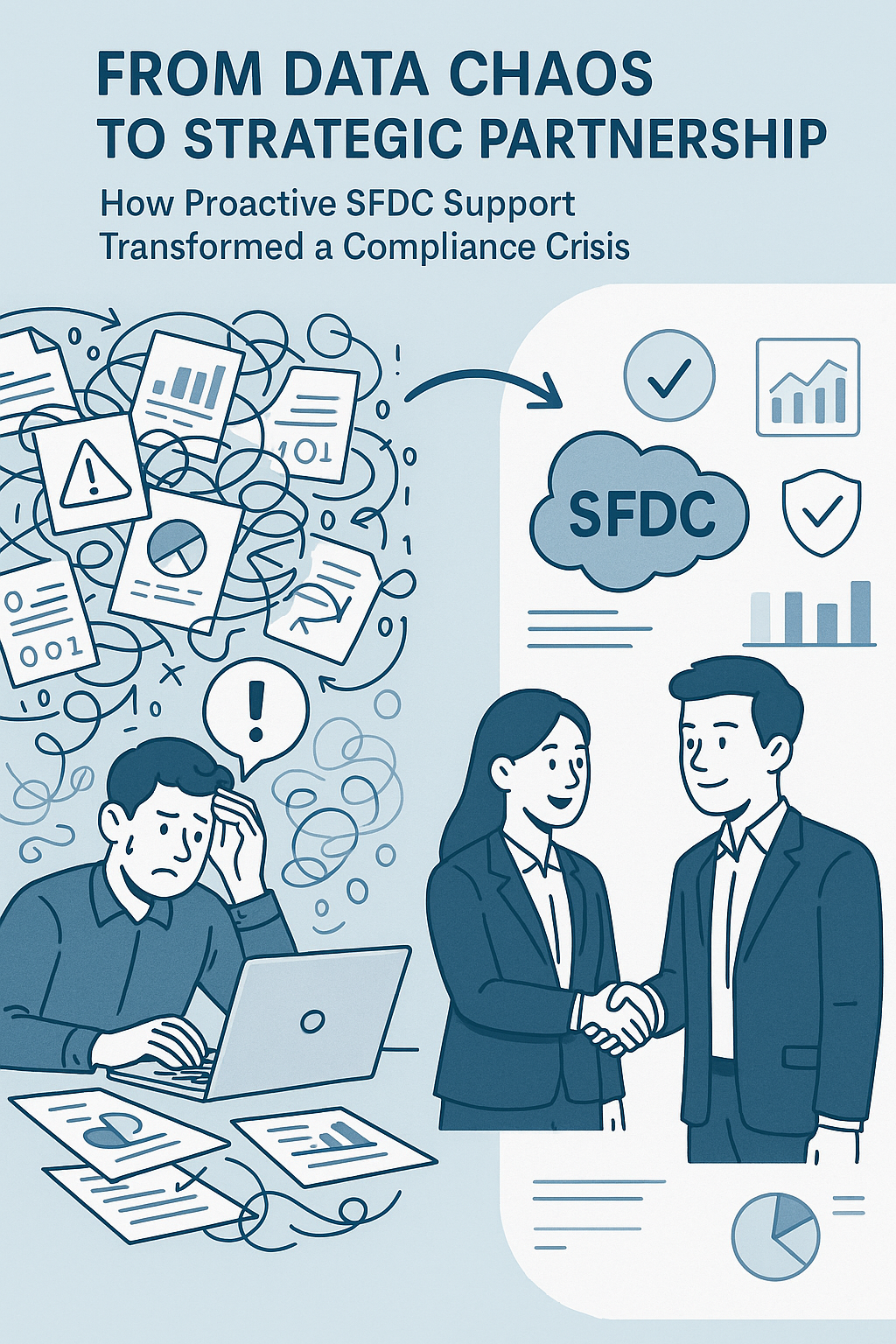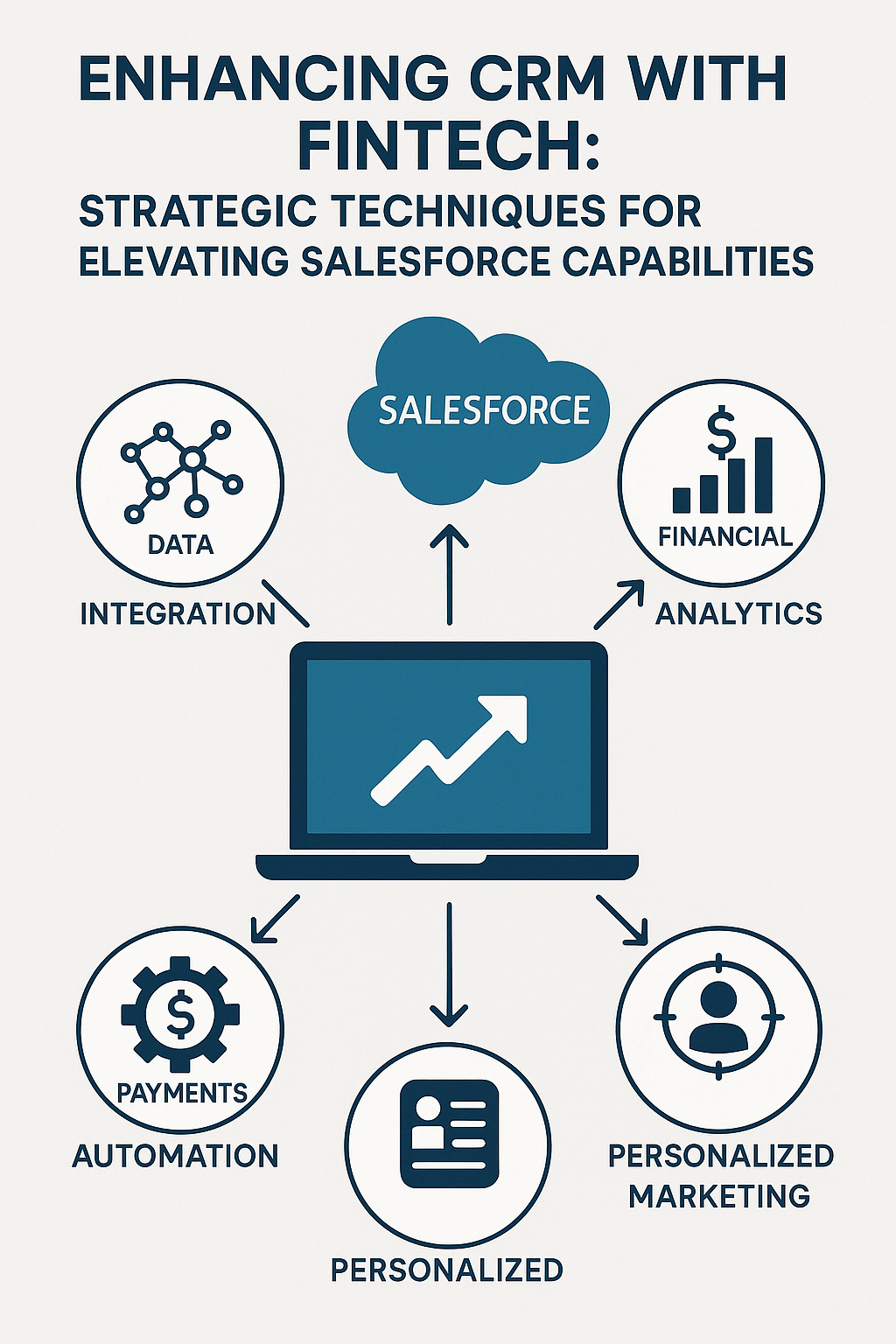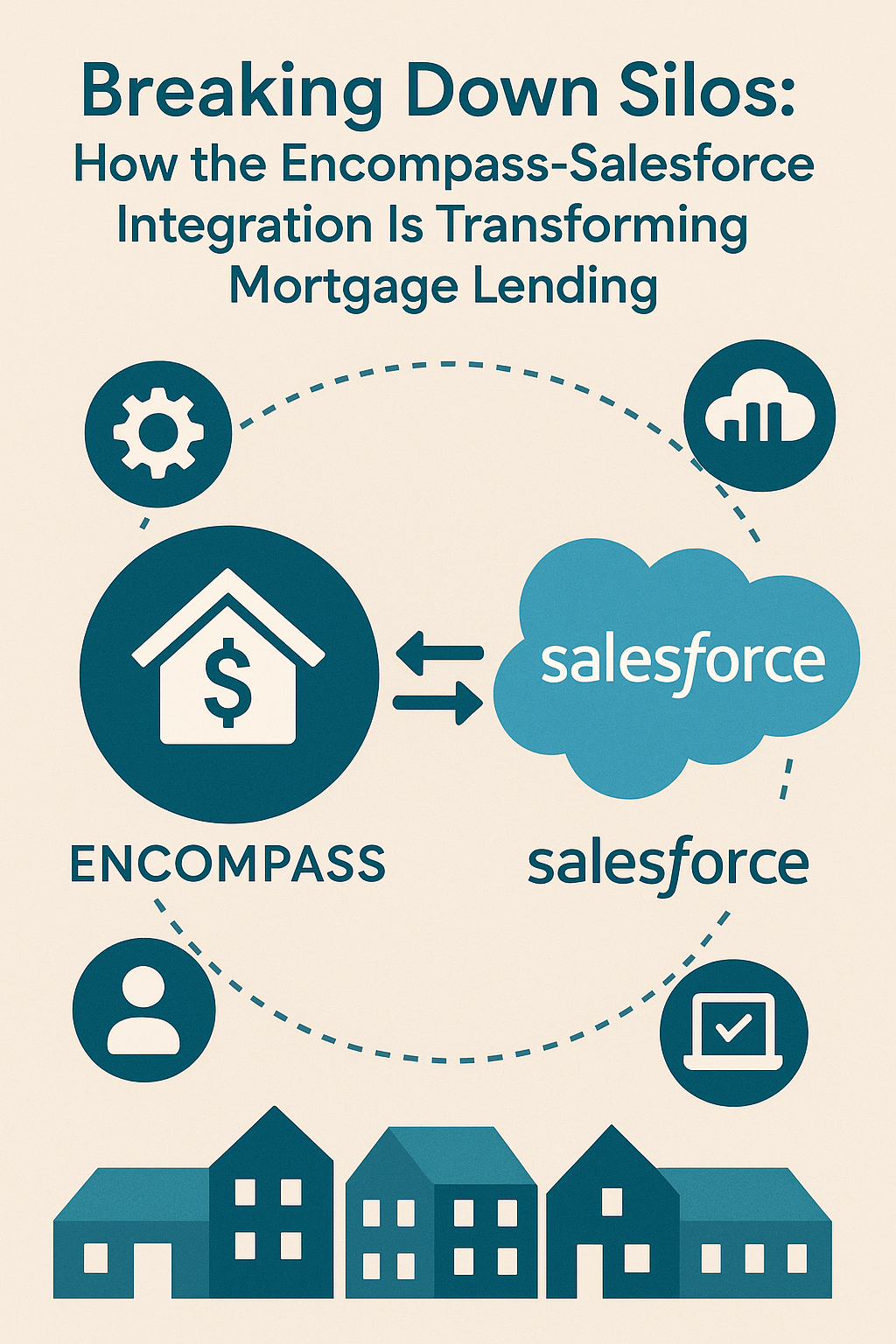
How the right consulting approach transforms crisis response into strategic partnership
Discover proven strategies for CRM migration in financial services. Learn how to master Salesforce Financial Services Cloud implementation with expert insights on data migration, integration, and compliance.
Picture this: It's late October, and your wealth management team is preparing for year-end client reviews. Your Salesforce Financial Services Cloud platform—the backbone of client relationship management and compliance reporting—is suddenly plagued with duplicate records, orphaned accounts, and data integrity issues that could trigger red flags during your next SEC audit.
Sound like a nightmare scenario?
For one prominent SEC-registered investment advisory firm, this wasn't hypothetical—it was their October 2025 reality. Following a major data integration from their third-party investment intelligence platform, their CRM had become a compliance liability rather than an asset.
But here's where the story takes an unexpected turn. What could have been a post-implementation disaster became the foundation for a strategic data governance partnership—all because of how their Salesforce consulting partner responded to the crisis.
In this case study, we'll explore how VantagePoint's proactive, consultative approach transformed a data emergency into lasting client value and reveal the lessons every financial services firm can apply to their own Salesforce operations.
The Crisis: When Data Integration Goes Wrong
The Immediate Problem
The firm's Salesforce Administrator reached out with an urgent concern. After loading data from their third-party investment intelligence platform, the CRM was experiencing critical data quality issues:
Duplicate Records Running Wild
- Multiple Account and Contact records for the same firms and individuals
- Duplicate CRD (Central Registration Depository) numbers threatening compliance accuracy
- Conflicting firm records that could undermine regulatory reporting
Legacy Data Creating Confusion
- Orphaned branch accounts cluttering the system
- Records with addresses embedded in names instead of proper fields
- Missing or invalid CRD numbers on legacy accounts
Operational Bottlenecks
- A Private Funds Associate had been requesting duplicate merge permissions for nearly two weeks
- Team members blocked from basic data management tasks
- No clear escalation path for resolving permissions constraints
The High Stakes
For wealth management firms operating in a heavily regulated environment, these aren't just annoying data problems—they're potential compliance nightmares.
Duplicate CRD numbers during a regulatory audit could:
- Trigger SEC examination findings
- Raise questions about firm recordkeeping practices
- Create confusion about actual client relationships
- Undermine the accuracy of compliance reporting systems
The firm needed more than a quick fix. They needed a partner who could see beyond the immediate crisis to the systemic issues creating ongoing risk.
The VantagePoint Response: Partnership Over Projects
When the client shared their third-party data export file on October 24th, Randy Wandell, Vice President of Professional Services at VantagePoint, could have simply executed the data load as requested and moved on to the next task.
Instead, he did something different—something that would define the entire engagement.
Day 1: Proactive Problem Identification (October 24)
After analyzing the data file, Randy immediately identified potential integration issues. Rather than proceeding blindly and dealing with cleanup afterward, he proactively delayed the load and proposed a collaborative troubleshooting call.
This decision embodied a core VantagePoint principle: data quality over speed.
In consulting, it's tempting to execute client requests quickly to demonstrate responsiveness. But true partnership means having the courage to pause, raise concerns, and recommend a better path forward—even when it means short-term delays.
Day 2-3: Real-Time Collaborative Problem-Solving (October 27)
The teams engaged in intensive troubleshooting throughout the day:
Morning: Randy identified load complications and coordinated scheduling with the client to review options together.
Midday: Despite scheduling conflicts requiring two reschedules, Randy proceeded with the data load and delivered comprehensive results, including detailed documentation of issues encountered.
Afternoon (3:45 PM): The client reviewed outputs and identified specific cleanup needs:
- Duplicate records requiring intelligent prioritization based on data completeness
- Legacy branch accounts marked by addresses in names without valid CRDs
- Need for systematic approach to prevent future occurrences
Rather than treating this as a simple support ticket to close, Randy offered to script automated cleanup for Accounts and Contacts, then export preview lists for the client's review before execution.
This approach balanced three critical needs:
- Technical efficiency through automation
- Client control through preview and approval
- Knowledge transfer through transparent process documentation
The Strategic Pivot: From Firefighting to Foundation-Building
As Randy worked through the immediate data crisis, he recognized something important: this wasn't just a one-time cleanup challenge. It was a symptom of missing data governance infrastructure.
The Permission Barrier Reveals Systemic Gaps
Parallel to the data crisis, Randy discovered that a team member's inquiry about merging duplicates had languished for 12 days since a previous consultant's departure. When Randy assumed ownership on October 17th, he immediately recognized this represented a broader issue.
The Problem: The firm's team couldn't perform routine data hygiene tasks themselves.
The Impact: Every duplicate record, every data quality issue created dependency on external support—slowing operations and increasing costs.
The Opportunity: Enabling self-service data management would prevent future bottlenecks while empowering the client's team.
By October 27th, Randy committed to resolving the permissions architecture within the week, positioning this not as a minor access issue but as a critical enabler of operational independence.
Converting Crisis Response into Strategic Services
Randy didn't just see 19 completed support tasks—he saw the foundation for four strategic service offerings:
The Transformation: Four Pillars of Data Governance
1. Automated Duplicate Detection & Prevention
The Challenge: Manual duplicate identification was reactive, time-consuming, and inconsistent.
The Solution: Randy proposed systematic duplicate management infrastructure:
- Intelligent Merge Logic: Automatically prioritize records with complete third-party integration data over empty legacy records
- CRD Validation Rules: Prevent future duplicate firm registrations at the point of data entry
- Automated Hygiene Workflows: Schedule regular scans for orphaned accounts and legacy records
- Smart Alerts: Notify administrators when potential duplicates meet specific criteria
Estimated Impact: 85% reduction in duplicate-related data quality issues
Client Value: Eliminate hundreds of hours annually spent on manual duplicate identification and cleanup
2. Enhanced Third-Party Integration Architecture
The Challenge: The initial load issues revealed gaps in how external data entered Salesforce.
The Solution: Build robust integration validation before data ever hits the CRM:
- Real-Time Sync Validation: Implement matching logic to verify CRD numbers, firm tiers, and classifications before creating new records
- Custom Flow Development: Build intelligent routing for third-party contact data through existing Salesforce flows
- Compliance-Grade Audit Trails: Ensure SEC-ready documentation of all external data changes
- Exception Handling: Create escalation workflows for records that don't match existing data
Projected Value: Eliminate 90% of manual post-load cleanup time
Compliance Benefit: Demonstrate to regulators that external data integration follows documented, validated processes
3. User Enablement & Permissions Architecture
The Challenge: Team members couldn't handle routine data management independently.
The Solution: Design tiered permissions that balance control with enablement:
- Role-Based Data Management: Enable associates to merge duplicates within defined parameters (e.g., same CRD number, same firm tier)
- Self-Service Training: Equip team members with documentation and workflows to handle routine data hygiene
- Escalation Protocols: Create clear pathways for complex data scenarios requiring consultant expertise
- Audit Controls: Maintain oversight while distributing operational capacity
Efficiency Gains: Estimated 40% reduction in support ticket volume through user enablement
Employee Impact: Reduce frustration from permission barriers and waiting for external support
4. Formalized Data Governance Partnership
The Challenge: High support activity existed without formal opportunity tracking or revenue capture.
The Solution: Transform ad-hoc support into structured strategic partnership:
- Data Governance Package: Formalize ongoing cleanup and prevention services into annual retainer (~$15-20K value)
- Integration Enhancement Opportunity: Capture advanced sync improvements as defined project (~$15K)
- Managed Services Expansion: Convert support into structured quarterly optimization reviews
- Strategic Advisory: Regular sessions to identify emerging data challenges and opportunities
Revenue Potential: $50K+ in formalized pipeline within 60 days
Client Benefit: Predictable costs, proactive problem prevention, and strategic guidance versus reactive firefighting
The Results: Immediate Wins and Long-Term Value
Immediate Crisis Resolution
✅ Rapid Response Issues identified and scripted solutions proposed within 3 days of initial file sharing
✅ Exceptional Execution 19 of 20 tasks completed during the engagement period, demonstrating velocity without sacrificing quality
✅ Zero Downtime All troubleshooting and corrections executed without disrupting daily operations
✅ Client Control Maintained Export lists prepared for review before executing bulk changes, ensuring transparency and approval
Strategic Foundation Established
Data Quality Infrastructure Systematic approach to eliminating duplicates and legacy records now prevents compliance risks before they manifest
Scalable Integration Architecture Third-party data connection positioned for growth without recurring cleanup cycles
Team Empowerment Roadmap Clear path to reducing dependency on external support for routine tasks while maintaining oversight
Enhanced Compliance Posture CRD validation rules and comprehensive audit trails strengthen SEC readiness and regulatory reporting accuracy
Partnership Evolution
From Transactional to Consultative Randy transformed data errors into strategic discussions about governance, positioning VantagePoint as trusted advisor
Transparent Communication Clear explanations of issues, options, and implementation approaches built client confidence
Collaborative Decision-Making Scripting + preview export approach demonstrated respect for client control while delivering technical expertise
Revenue Relationship Maturity Service delivery positioned to capture formal opportunity value through documented, measurable business impact
The Path Forward: Q4 2025 and Beyond
As the firm closes out 2025, they're positioned to evolve from reactive data management to proactive governance:
Immediate Priorities (Next 30 Days)
- Formalize Data Governance Package opportunity with defined scope and pricing
- Resolve permissions architecture to enable team self-service for routine operations
- Document automated cleanup scripts for ongoing use
Short-Term Initiatives (60 Days)
- Launch quarterly CRM optimization reviews to identify emerging issues early
- Expand key contact relationships across the organization beyond single administrator
- Implement first phase of duplicate prevention validation rules
Long-Term Strategic Goals (Q1 2026)
- Deploy advanced third-party integration enhancements with real-time validation
- Explore automated compliance reporting capabilities leveraging clean, governed data
- Expand governance framework to additional data sources and systems
Key Lessons for Financial Services Firms
1. Treat Data Integration as Strategic, Not Tactical
Post-load cleanup isn't just IT work—it's a compliance and efficiency imperative requiring governance planning from day one.
Action Item: Before your next third-party integration, invest in matching logic, validation rules, and exception workflows. The hours spent on prevention save weeks on correction.
2. Permissions Architecture Enables Productivity
Small access gaps cascade into dependency on external support, creating bottlenecks that slow operations and frustrate teams.
Action Item: Review your Salesforce permissions quarterly. Can your team handle routine tasks independently? Where are the unnecessary barriers to productivity?
3. Convert Support Volume into Revenue Opportunities
High email and call activity without pipeline tracking leaves money on the table—and fails to capture the true value of services delivered.
Action Item: If your consulting partner is handling significant support volume, ensure there's a formal opportunity tracking the ongoing value and positioning natural service expansions.
4. Partner with Consultants Who See the Big Picture
Look for partners who don't just execute tasks—they identify systemic gaps and position solutions that scale with your business.
Red Flags:
- Consultants who immediately execute requests without asking questions
- Focus on task completion metrics rather than business outcomes
- Reactive problem-solving without addressing root causes
Green Flags:
- Proactive identification of issues before execution
- Strategic recommendations beyond the immediate request
- Investment in knowledge transfer and client enablement
5. Leverage Crises as Trust-Building Moments
Responsive support during data emergencies creates credibility for strategic conversations. The way you handle problems defines the partnership.
The Test: When something goes wrong, does your consultant:
- Disappear until there's a solution?
- Blame the client or their data?
- Work transparently, communicate frequently, and involve you in decision-making?
The third approach builds partnerships. The first two burn bridges.
Why This Story Matters
This investment firm's journey from data crisis to governance partnership demonstrates a fundamental truth about Salesforce consulting: the best engagements happen when consultants see beyond the immediate task to the strategic opportunity.
Randy didn't just fix a data integration issue. He helped the client see data quality as a strategic asset they could systematically manage and protect. That shift in perspective transformed a one-time firefight into an ongoing partnership that delivers measurable value.
The difference between transactional support and strategic partnership often comes down to a single question:
"How can we prevent this from happening again?"
When consultants ask that question—and commit to answering it—clients stop seeing them as vendors and start seeing them as partners.
Is Your Firm Facing Similar Challenges?
If you're experiencing:
- Duplicate records from third-party integrations
- Data quality issues threatening compliance accuracy
- Team members blocked by permissions constraints
- Reactive firefighting instead of proactive data governance
- Consulting relationships that feel transactional rather than strategic
...then you're not alone. These challenges are common in financial services Salesforce implementations, but they're solvable with the right approach.
How VantagePoint Can Help
100% Financial Services Focus
We work exclusively with banks, credit unions, investment advisors, wealth management firms, and fintech companies. This specialization means we understand your regulatory environment, compliance requirements, and business processes—not just Salesforce technology.
Data Governance Expertise
We've helped dozens of financial services firms establish systematic approaches to data quality, duplicate management, and third-party integration validation. Our frameworks are built for regulated environments where data accuracy isn't optional.
Senior-Level, Proactive Consulting
Every VantagePoint consultant is a senior-level professional who thinks strategically, communicates transparently, and proactively identifies opportunities for value creation. You won't get junior staff executing tasks—you'll get experienced advisors solving business problems.
Proven Track Record
With 400+ successful engagements, 150+ clients, and a 95%+ retention rate, we've built our reputation on turning challenging situations into success stories. Many clients come to us after failed implementations with other vendors—and stay with us for years of strategic partnership.
Ready to Transform Your Salesforce Data Challenges?
We understand that every firm's data landscape is unique. That's why we start every engagement with comprehensive discovery to understand your specific challenges, systems, and goals.
Let's Start a Conversation
Schedule a complimentary data governance assessment where we'll:
- Review your current data quality challenges and pain points
- Assess your third-party integration architecture
- Identify quick wins and long-term strategic opportunities
- Share relevant case studies from similar financial services firms
- Provide honest guidance on whether we're the right fit for your needs
Contact Information:
- Email: sales@vantagepoint.io
- Phone: +1 (469) 499-3400
- Website: vantagepoint.io
Don't wait for a data crisis to discover the gaps in your Salesforce governance. Let's build the foundation for data quality, compliance confidence, and operational efficiency—before the next audit or integration challenge arrives.
Related Resources
Learn More About VantagePoint's Data Governance Solutions:
- Data Migration & Integration Services
- Financial Services Cloud Implementation
- Compliance & Security Solutions
Additional Case Studies:
- Leading Mortgage Lender Partners with VantagePoint to Turnaround Salesforce Implementation
- Growth by Optimization and Automation for a Mortgage Enterprise
About the Author
David Cockrum is the founder of Vantage Point and a former COO in the financial services industry. Having navigated complex CRM transformations from both operational and technology perspectives, David brings unique insights into the decision-making, stakeholder management, and execution challenges that financial services firms face during migration.
Ready to begin your CRM migration journey?
Partner with Vantage Point to benefit from proven frameworks, specialized expertise, and a structured approach that de-risks your migration while accelerating time-to-value.
-
-
- Email: david@vantagepoint.io
- Phone: 469-499-3400
- Website: vantagepoint.io
-



